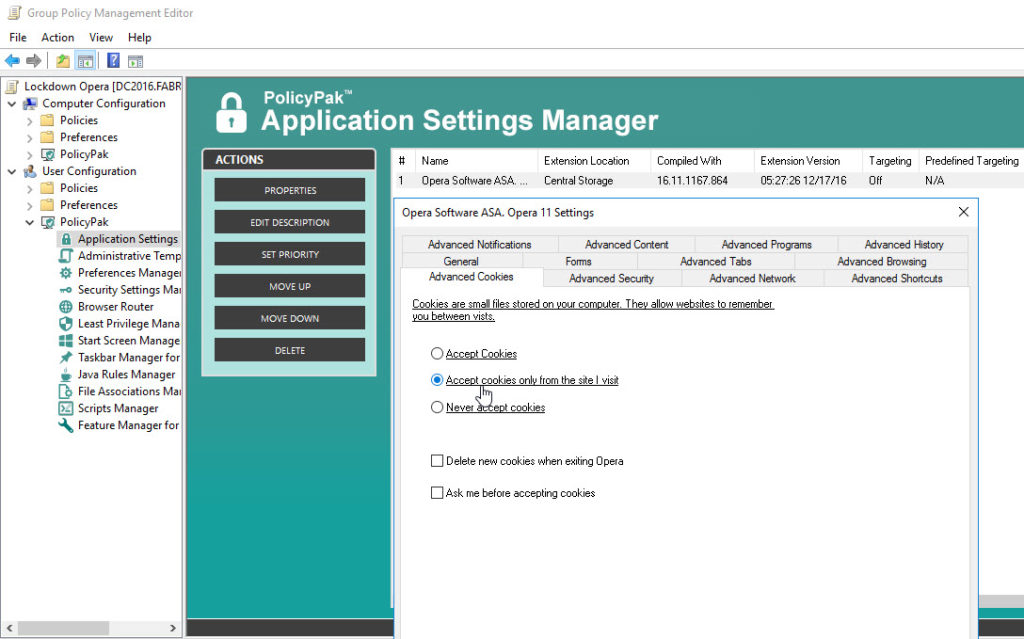So much of what users do today involves web browsers like Opera, and there’s so much that can go wrong.
And that’s where PolicyPak comes in. We enforce and lock down the optimum settings that you, the administrator, want them to have. PolicyPak sets and enforces expectations for your users’ applications, so that they get the same experience, every time they launch it.
Keep your Opera configuration settings enforced and streamlined with PolicyPak. Check out these videos to see how it’s done:
Opera’s Regular ReleasesOpera “Next”
With PolicyPak, you’re the one in control.
Besides, once you’re using PolicyPak to manage Opera, you’ll also get to manage all your other enterprise desktop applications the same way: Flash, Lync, Java, Firefox, and any custom applications you have. They’re 100% included – absolutely free.
It’s all included when you’re a PolicyPak Professional customer.
PolicyPak was designed by Microsoft MVP, Enterprise Mobility Jeremy Moskowitz – who “wrote the book” on Group Policy, runs GPanswers.com, and lives and breathes Group Policy and enterprise software deployments and desktop lockdown.
When you’re ready to get serious about managing Opera, PolicyPak is ready for you.
Manage Opera with Group Policy video transcript
Hi, this is Jeremy Moskowitz, Microsoft MVP, Enterprise Mobility and Founder of PolicyPak Software. In this video, we’re going to learn how to manage the Opera web browser using PolicyPak.
I’ve already got Opera installed on my computer, and I’m just a regular user here. As you can see, I’m logged on as a guy called “eastsalesuser4.” If we open up this application from the start menu and go to Settings | Preferences we see a number of settings here for us to configure.
I’ll start with “General” where I can enforce the home page for my users and how the browser will deal with pop-up ads. In Advanced I have some important configuration grouping such as “Content,” “History,” “Cookies” and “Security.”
Let’s see how we can ensure compliance and perform desktop management of settings quickly using PolicyPak. I’ll go ahead and switch over to my Management Station computer.
We’ll go ahead and right click over our “East Sales Users”, “Create a GPO” and we’re going to call it “Manage Opera 12.” So this GPO is now associated with the “East Sales Users.” I’ll right click over it. I’ll click “Edit…” I’ll dive down under “User Configuration,” “PolicyPak/Applications/New/Application.” There it is, “PolicyPak for Opera” along with other applications like “Java,” “Flash” “Firefox,” “Skype” and lots of other important desktop applications that your users utilize every day (and you want to make more secure.).
Let’s start with “General” where I can ensure that my users always get a consistent home page. Then I’ll go to pop-ups and set it to “Block unwanted pop-ups.” To make it easier for my users, I’ll next go to “Notifications” and enable “Show notification for blocked pop-ups” as well as “Show notification for finished downloads.” Notice how the setting became underlined as soon as the checkbox value changed. This means that the setting value is going to be delivered through PolicyPak.
As a Network Administrator, my first concern is always security so let’s go to the “Security” tab and make sure that “Enable Fraud and Malware Protection” is always enabled. Let’s also make sure that “Ask websites not to track me” is checked as well. Then let’s go into “Security Protocols” and make sure that “Enable SSL 3 and TLS 1” is selected. While I’m at it, let’s set Auto-Update to “Do Not Check for Updates.” Finally, let’s go to Advanced Programs and make sure that “Check if Opera is default browser on startup” is unchecked and in Browsing, let check “Spelling.”
Now I will go back to my client machine, we’ll get a command prompt and run “gpupdate.” Now you could envision the user logging on for the very first time, using a Terminal Services or Citrix machine, using a VDI session, changing job roles, or getting a new computer. I just happen to be using gupdate.
Now that that’s done, let’s go ahead and reopen the application. We can see that our desired settings for “General” as well we all desired settings on both “Notifications” and most importantly, or setting within “Security.” We can also see that our setting in Programs and Browsing has been delivered as well.
Just to demonstrate the controlling power of PolicyPak, let’s pretend that eastsalesuser4 is trying to modify and work around your settings. I know you know users who love to do this, and make the machine less optimal and secure.
Now let’s close the application and reopen it and we see once again that PolicyPak has simply reverted the user’s settings right back to your desired settings. Even if the user is offline, your settings are always preserved because PolicyPak is always working for you in the background, making the job of you the administrator, easier.
PolicyPak performs the magic. To get the magic delivered, you can use Group Policy, SCCM, LanDesk, KACE or your own systems management software. We just happen to be using Group Policy to deliver PolicyPak directives in this demonstration.
And we are done. That is how incredibly easy it is for you to use PolicyPak to manage Opera as well as tons of other desktop applications.
If you’re looking for a trial of PolicyPak, just click on the “Webinar / Download” button on the right.
Thanks so much for watching, and get in touch with us if you’re looking to get started. Talk to you soon.






